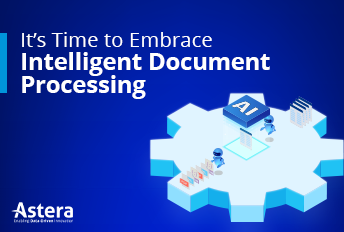
AI Data Extraction Is a Must-Have for Modern Businesses
According to a recent survey by IDC, AI is the top investment priority for modern organizations, and it’s easy to see why. From enhancing customer experiences and driving automation to improving decision-making, AI has transformed how businesses operate across multiple fronts. Data extraction is one of the most exciting areas where AI is making an impact. With AI-powered solutions, organizations can now seamlessly extract valuable insights from unstructured files, speeding up processes and unlocking new growth opportunities. It’s an exciting time to explore how AI is changing how we think about data!
What is AI Data Extraction?
AI data extraction refers to using artificial intelligence technologies to gather and process information from various data sources. It’s particularly valuable for extracting insights from unstructured data, which can come from text, images, and other non-tabular formats.
AI is No Longer Optional for Data Extraction
As businesses deal with an increasing amount of unstructured data—such as contracts, reports, and emails—manual data extraction processes fall short. AI offers a more accurate and efficient solution to ingest data, removing the risk of human error and speeding up critical tasks. Automating data extraction allows organizations to reduce costs and improve productivity, allowing their teams to focus on higher-value activities.
What sets AI apart is its ability to adapt. Unlike traditional methods, AI can analyze and extract data from diverse formats and adapt to new document structures as they emerge. This ability to evolve with changing data needs makes AI a critical tool for businesses looking to streamline their operations and make faster decisions.
The Benefits of AI-Driven Data Extraction
- Increased Efficiency
AI systems process large volumes of data at remarkable speeds. According to a survey by MIT Sloan, 87% of organizations worldwide believe AI technologies will give them a competitive edge. For example, AI can analyze thousands of invoices in just a few minutes, which would typically require several days to complete if done manually. Techniques such as natural language processing (NLP) quickly comprehend and extract critical information, making the entire data processing pipeline much faster and more efficient.
- Cost Savings
Automating repetitive data extraction tasks with AI significantly lowers labor costs. A recent study by PwC found that even the most basic AI-based extraction techniques can save businesses 30–40% of the hours typically spent on these processes. Reallocating resources from manual tasks to more strategic initiatives enable organizations to maximize ROI on employee costs.
- Greater Flexibility
AI data extraction can handle various document formats, enabling organizations to process diverse data types efficiently. Whether PDFs, scanned images, or structured databases, AI algorithms can accurately extract critical information. For example, in insurance, AI captures key details like claim amounts and policy numbers from documents in different formats accurately.
The Step-by-Step Process of AI Data Extraction
AI data extraction involves several key steps that transform raw data into actionable insights. Here’s a closer look at the process:
- Data Collection: The process begins with gathering data from various sources, such as applications, databases, and systems like ERPS and CRMs. Most of this data is unstructured in format, especially documents like invoices, contracts, emails, and reports.
- Preprocessing: Once the data is collected, it needs to be cleaned and organized. This step involves removing irrelevant information and noise that could interfere with the extraction process. Standardizing formats is also essential to ensure consistency across different data types.
- Data Extraction: AI data extraction involves using natural language processing to identify, classify, and extract data from unstructured files. The AI identifies the type of information and stores it as metadata, as per the logic defined by the user.
- Data Validation: Validating the accuracy of the data after extraction is crucial for maintaining the integrity of the data. Organizations can apply data quality checks and pre-defined rules to ensure the extracted output is accurate and complete.
- Integration and Storage: The final step involves integrating the extracted data into existing systems or databases, making the information accessible for analysis and decision-making.
How AI Data Extraction Drives Efficiency Across Various Sectors
AI data extraction is making significant strides across various industries, streamlining processes and enhancing efficiency. Here are some applications that showcase how AI data extraction is driving value in different sectors.
- Healthcare: Enhancing Patient Data Management
Quick access to patient information is vital in healthcare. AI data extraction automates data collection from medical records and lab reports, enabling providers to create detailed patient profiles. This immediate access supports accurate diagnoses and timely treatments, ultimately improving patient care.
- Finance: Optimizing Invoice Processing
For financial institutions, managing invoices and receipts efficiently is crucial. AI data extraction automates data retrieval from financial documents, cutting down on manual entry errors and processing times. This technology enhances compliance with regulations, allowing organizations to focus on strategic financial decisions.
- Insurance: Streamlining Claims Processing
In the insurance sector, fast and accurate claims processing is key to customer satisfaction. AI data extraction automates the retrieval of relevant information from claims forms and supporting documents. This accelerates the claims resolution process, reduces errors, and enhances the customer experience.
Final Thoughts
As businesses continue to deal with growing volumes of unstructured data, using AI-driven tools for data extraction is essential. These advanced solutions automate the extraction process, enabling organizations to access critical information promptly and make informed decisions that drive performance.
Astera’s Intelligent Document Processing (IDP) platform stands out with its AI-powered, template-less data extraction capabilities. Designed to handle a wide variety of document types and layouts—from invoices to contracts—the system eliminates the need for predefined templates. This adaptability makes it ideal for businesses dealing with diverse formats, as the platform intelligently identifies patterns in different documents. With Astera’s IDP, companies can achieve quicker, more accurate data extraction, allowing them to focus on leveraging insights without manual intervention.
Discover how AI can streamline your document processing. Contact us today!

 Astera AI Agent Builder - First Look Coming Soon!
Astera AI Agent Builder - First Look Coming Soon!

